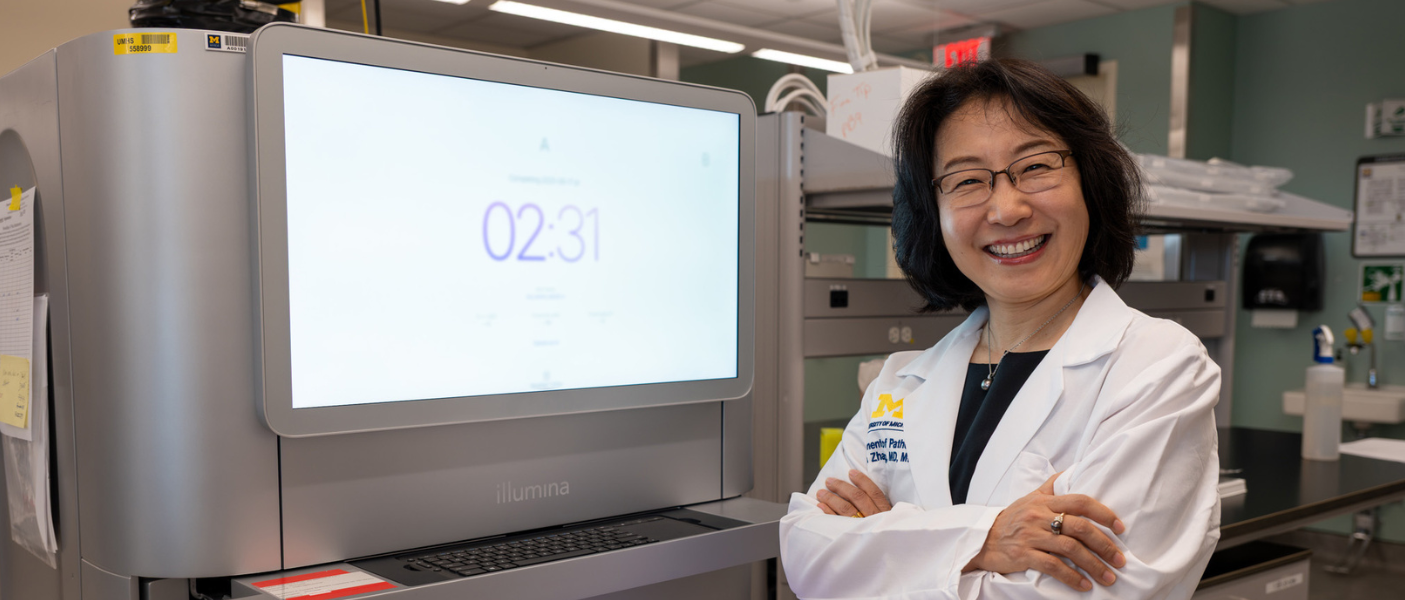

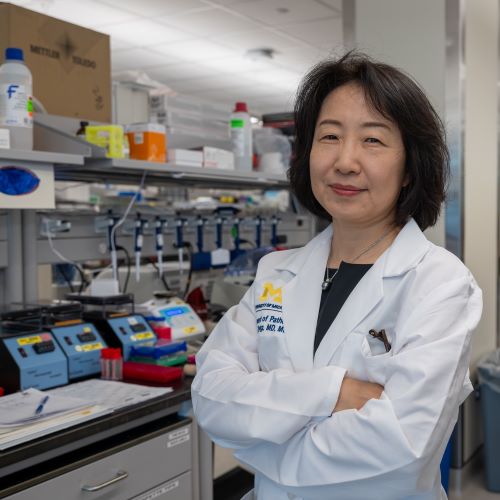 The Department of Pathology is home to world-class faculty from around the world. One of these is Dr. Kejian Zhang, clinical professor and director of the molecular genetics laboratory in the Division of Genetics and Genomics. Zhang originally came to the United States to learn how to perform clinical research. “I started at the Cincinnati Children’s Hospital performing research in the Hematology Oncology department. I was there for seven or eight years before I started my fellowship in human genetics. Two years later, I obtained board certification by the American Board of Medical Genetics and Genomics.”
The Department of Pathology is home to world-class faculty from around the world. One of these is Dr. Kejian Zhang, clinical professor and director of the molecular genetics laboratory in the Division of Genetics and Genomics. Zhang originally came to the United States to learn how to perform clinical research. “I started at the Cincinnati Children’s Hospital performing research in the Hematology Oncology department. I was there for seven or eight years before I started my fellowship in human genetics. Two years later, I obtained board certification by the American Board of Medical Genetics and Genomics.”
Zhang grew up in China and graduated from Tianjin Medical University. However, growing up, Zhang wanted to be a teacher. “My mom told me no, that I was the only girl in the family, and she wanted a doctor in the family. I should be a doctor. I was a very good kid, and I listened to my mother and said I would try that.” Zhang’s testing scores were high enough to make it into medical school, and she was told that she could become a professor of medicine. “That is how I decided to become a doctor, and I love it! When you are 18 years old, you don’t really know what you should be doing. Sometimes moms know us better than we know ourselves.”
During her residency training in China, she had a patient who was not responding to prescribed antibiotics in the hospital. She began ordering tests to determine the cause of the infection. “I wanted to get the result, so I ran upstairs to the laboratory to see if the results were ready yet. I had made friends with the director of the microbiology lab there. She gave me the results for my patient, which indicated a need for a rarely used drug, and my patient recovered.” That is when Zhang understood the importance of knowing the specific pathogen causing the typical symptoms of fever, lung congestion, and cough. Zhang became interested in the causes of disease. When an opportunity arose to come to the United States to research the causes of blood cancer, she took it.
Her mentor was Dr. Robert J. Arceci, a highly regarded pediatric oncologist and the director of Hematology/Oncology at Cincinnati Children’s Hospital. Zhang’s first project was to find the genetic cause of leukemia. “We sequenced a bunch of leukemia patients’ mRNAs. When I started, we did chromosomal analyses, and then sequencing. It took a long time and used radioactive and toxic material, so we had to be very careful. We would only get 50 bases at a time, and we would have to run it many times to get the entire gene sequence. It took many years, but this resulted in my first publication in Blood.”
Later, PCR testing began to be used in the clinical setting. The “rapid-cycle” PCR instrument uses very thin glass capillaries through which a liquid flows to read the results. “It was revolutionary but also extremely fragile, requiring careful handling because it was so expensive.” Zhang pursued an MBA while conducting her research, which she completed in 2001, shortly after giving birth to her son. “I was considering moving into industry as I thought that would be the best use of my MBA. Then my mentor mentioned a genetic fellowship in the Division of Human Genetics. So I went to talk to the fellowship director, and we clicked. He already had a fellow and did not need another one, but he took me anyway.”
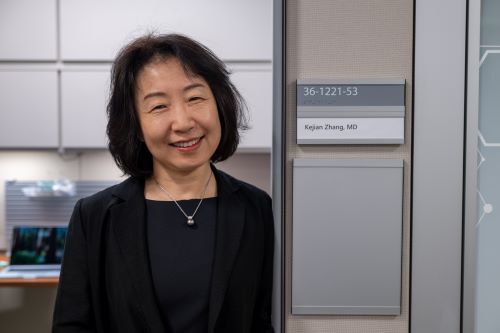 In her new position, she began studying a gene related to hearing loss. Dr. John Greenwald was starting a new genetic testing program for hearing loss patients, and Zhang’s mentor, Dr. Richard J. Wenstrup, began collaborating with him. “Working with him, I learned about not only the genetics of hearing loss, but also the culture of Deafness. Some who are Deaf do not want their children to hear, but some of them do. Also, some types of deafness are syndromic and can be associated with loss of sight. One of these is Usher Syndrome, which is a condition where patients first lose their night vision, and later lose their sight entirely.” Zhang’s research career flourished, and she published more than 100 peer-reviewed publications.
In her new position, she began studying a gene related to hearing loss. Dr. John Greenwald was starting a new genetic testing program for hearing loss patients, and Zhang’s mentor, Dr. Richard J. Wenstrup, began collaborating with him. “Working with him, I learned about not only the genetics of hearing loss, but also the culture of Deafness. Some who are Deaf do not want their children to hear, but some of them do. Also, some types of deafness are syndromic and can be associated with loss of sight. One of these is Usher Syndrome, which is a condition where patients first lose their night vision, and later lose their sight entirely.” Zhang’s research career flourished, and she published more than 100 peer-reviewed publications.
While at Cincinnati Children’s Hospital, Zhang continued to develop and was appointed as the Associate Director for the Molecular Genetics Laboratory. In 2006, Zhang was promoted to the role of laboratory director, a position she held for eleven years. “During that time, I grew our lab from about six people to more than 60 – a ten-fold increase, while being profitable and fully supporting ourselves. I am very proud of that accomplishment.” Under Zhang’s leadership, the lab became one of the top academic molecular diagnostic reference centers in the nation. In 2017, Zhang was promoted to the rank of professor.
Zhang left Cincinnati Children’s to join a start-up company called Mount Sinai Genomics, which spun out from Mount Sinai Health System. The name changed to Sema4 and later merged with GeneDx. However, shortly after the COVID-19 pandemic, Zhang’s father was diagnosed with cancer, and she returned to China to care for him. While there, she took a position with a private medical institution where she was responsible for developing their laboratory services. They wanted to receive CAP certification so they could work with researchers around the world for clinical trials of novel immune and cellular therapies. It was a remote position, enabling her to care for her dad. The lab was CAP certified last year, and her father lost his battle with cancer.
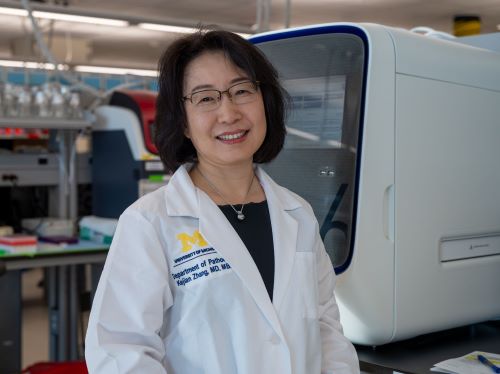 Zhang began considering her options as Dr. Annette Kim started recruiting for the Division of Genetics and Genomics at Michigan. In August 2025, Zhang was recruited as the Director of the Molecular Genetics Laboratory (MGL). “The MGL focuses on germline, heritable disease, mostly non-cancer, but it also looks at cancer predisposition.” Zhang came on board, and “about a month after I started, we were able to push whole genome sequencing over the finish line for research.” This research will be conducted in a CLIA-certified laboratory with at least 10,000 samples per year being run using the NovaSeq. “I need to be sure that ongoing quality control and validation are completed to ensure we can handle this level of testing.” The goal is to move whole genome sequencing into the clinical care arena. We are currently running panels for genetic testing, such as newborn screening confirmation testing, cystic fibrosis, and cancer predisposition. We have more than 40 panels representing more than 400 genes. We want to move this to whole genome sequencing in collaboration with our Michigan Medicine physicians.”
Zhang began considering her options as Dr. Annette Kim started recruiting for the Division of Genetics and Genomics at Michigan. In August 2025, Zhang was recruited as the Director of the Molecular Genetics Laboratory (MGL). “The MGL focuses on germline, heritable disease, mostly non-cancer, but it also looks at cancer predisposition.” Zhang came on board, and “about a month after I started, we were able to push whole genome sequencing over the finish line for research.” This research will be conducted in a CLIA-certified laboratory with at least 10,000 samples per year being run using the NovaSeq. “I need to be sure that ongoing quality control and validation are completed to ensure we can handle this level of testing.” The goal is to move whole genome sequencing into the clinical care arena. We are currently running panels for genetic testing, such as newborn screening confirmation testing, cystic fibrosis, and cancer predisposition. We have more than 40 panels representing more than 400 genes. We want to move this to whole genome sequencing in collaboration with our Michigan Medicine physicians.”
But sequencing the genes is only the first piece of the puzzle for patients. “We also need to provide informative interpretations of the results. This is very important for families. You can call out a VUS (variant of unknown significance), but it won't help the family or improve patient care. With whole genome sequencing, we can examine not only the variations in the genome but also the non-coding regions, and large complex structural alterations. In addition, we need to make this testing fast. A NICU baby is sick and needs answers quickly. Genetic testing results change the management for 30-50% of these babies. They cannot wait a month to get their results; it must be fast.”
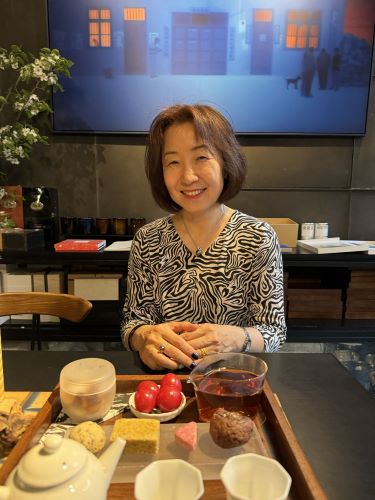 Being able to make a difference for patients brings Zhang great joy in her work. “Finding answers to the mystery cases and being able to give families a definitive answer that can change their kid’s life makes me happy.” Personally, Zhang loves to be active, whether it is running, swimming, tennis, pilates, yoga, or her new hobby, pickleball. “It makes me feel so good to exercise and get sweaty, then go home and have a shower – I feel so refreshed.” She also loves to try out different ethnic cuisines, and enjoys Ann Arbor’s many restaurants and is particularly pleased with the department’s fresh produce distributions. “Christine [Baker] knocked on my door one day and dropped off some fresh basil. It was so nice!”
Being able to make a difference for patients brings Zhang great joy in her work. “Finding answers to the mystery cases and being able to give families a definitive answer that can change their kid’s life makes me happy.” Personally, Zhang loves to be active, whether it is running, swimming, tennis, pilates, yoga, or her new hobby, pickleball. “It makes me feel so good to exercise and get sweaty, then go home and have a shower – I feel so refreshed.” She also loves to try out different ethnic cuisines, and enjoys Ann Arbor’s many restaurants and is particularly pleased with the department’s fresh produce distributions. “Christine [Baker] knocked on my door one day and dropped off some fresh basil. It was so nice!”
We are delighted to have Dr. Zhang join our department. Please give her a warm Michigan welcome!
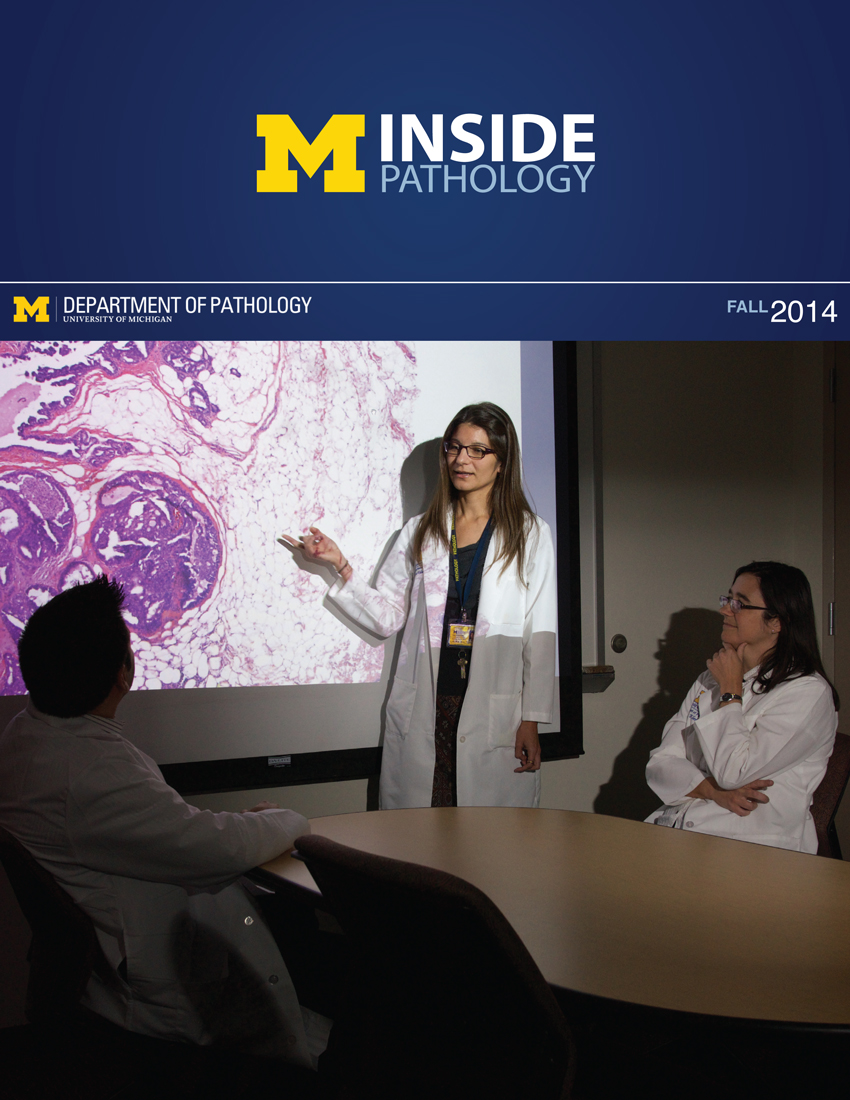 ON THE COVER
ON THE COVER
Breast team reviewing a patient's slide. (From left to right) Ghassan Allo, Fellow; Laura Walters, Clinical Lecturer; Celina Kleer, Professor. See Article 2014Department Chair |

newsletter
INSIDE PATHOLOGYAbout Our NewsletterInside Pathology is an newsletter published by the Chairman's Office to bring news and updates from inside the department's research and to become familiar with those leading it. It is our hope that those who read it will enjoy hearing about those new and familiar, and perhaps help in furthering our research. CONTENTS
|
 ON THE COVER
ON THE COVER
Autopsy Technician draws blood while working in the Wayne County morgue. See Article 2016Department Chair |

newsletter
INSIDE PATHOLOGYAbout Our NewsletterInside Pathology is an newsletter published by the Chairman's Office to bring news and updates from inside the department's research and to become familiar with those leading it. It is our hope that those who read it will enjoy hearing about those new and familiar, and perhaps help in furthering our research. CONTENTS
|
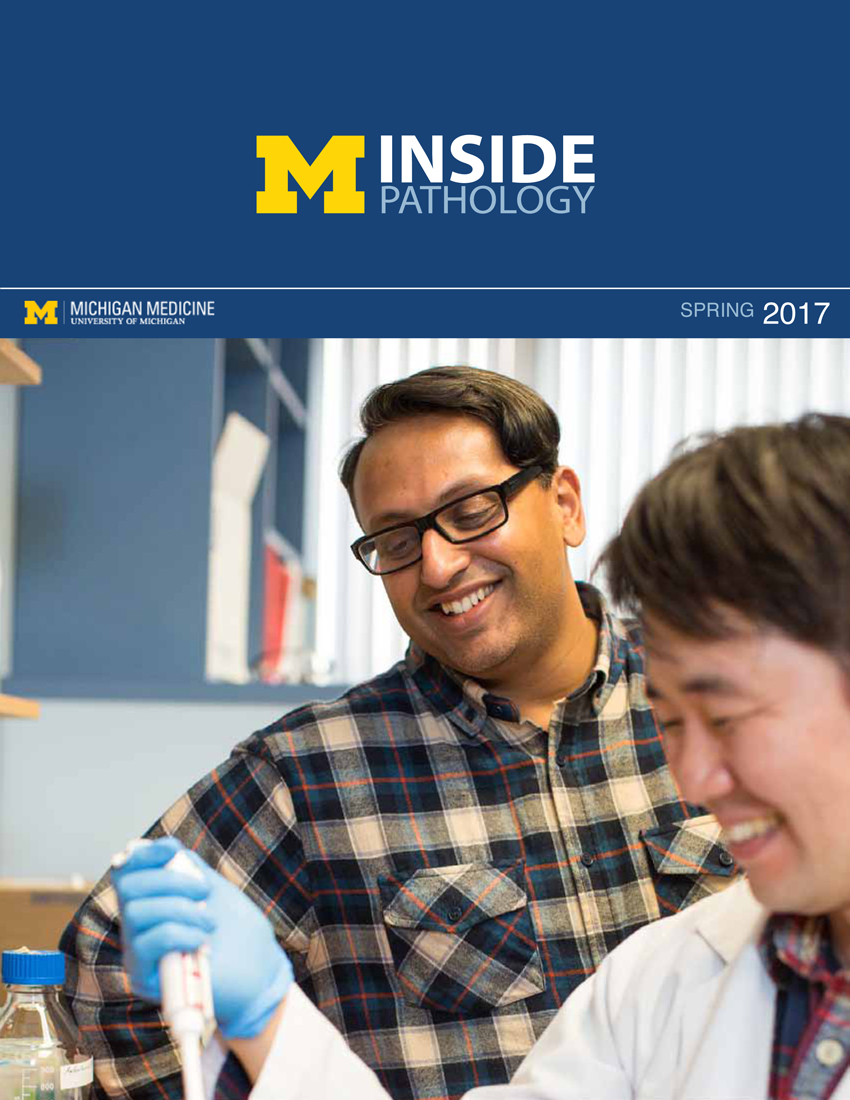 ON THE COVER
ON THE COVER
Dr. Sriram Venneti, MD, PhD and Postdoctoral Fellow, Chan Chung, PhD investigate pediatric brain cancer. See Article 2017Department Chair |

newsletter
INSIDE PATHOLOGYAbout Our NewsletterInside Pathology is an newsletter published by the Chairman's Office to bring news and updates from inside the department's research and to become familiar with those leading it. It is our hope that those who read it will enjoy hearing about those new and familiar, and perhaps help in furthering our research. CONTENTS
|
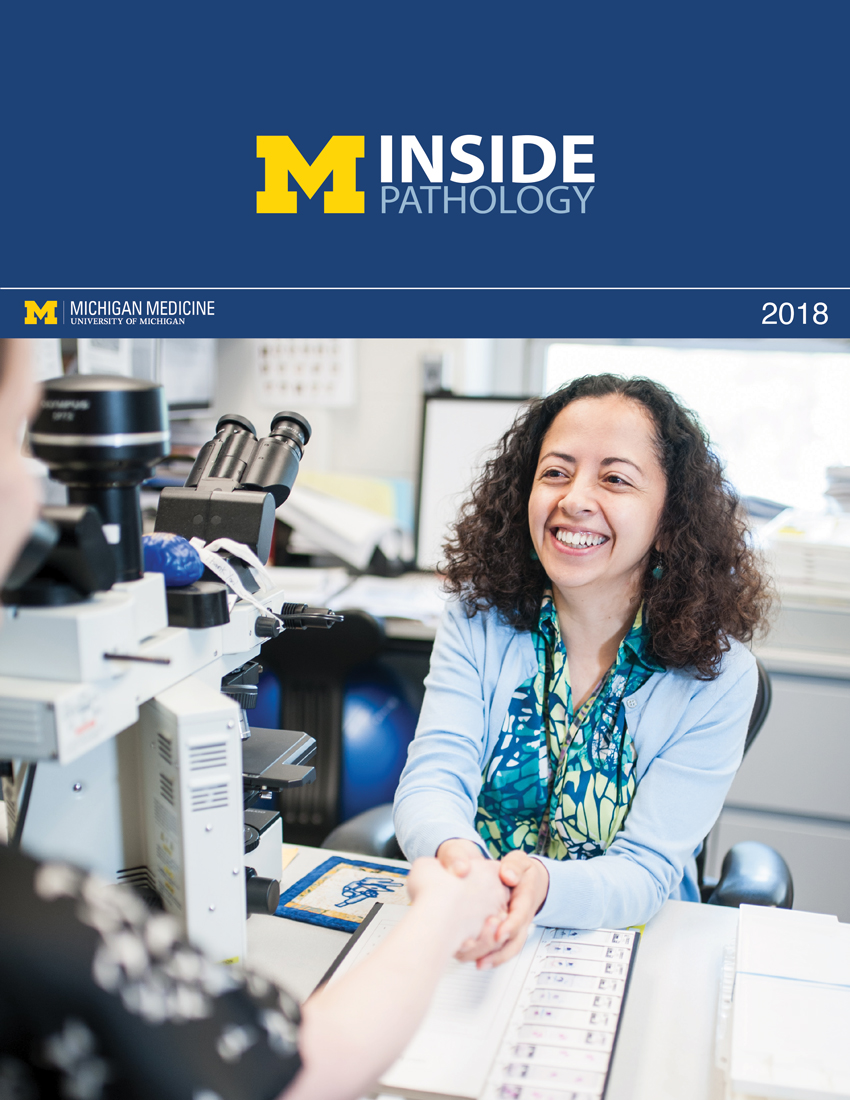 ON THE COVER
ON THE COVER
Director of the Neuropathology Fellowship, Dr. Sandra Camelo-Piragua serves on the Patient and Family Advisory Council. 2018Department Chair |

newsletter
INSIDE PATHOLOGYAbout Our NewsletterInside Pathology is an newsletter published by the Chairman's Office to bring news and updates from inside the department's research and to become familiar with those leading it. It is our hope that those who read it will enjoy hearing about those new and familiar, and perhaps help in furthering our research. CONTENTS
|
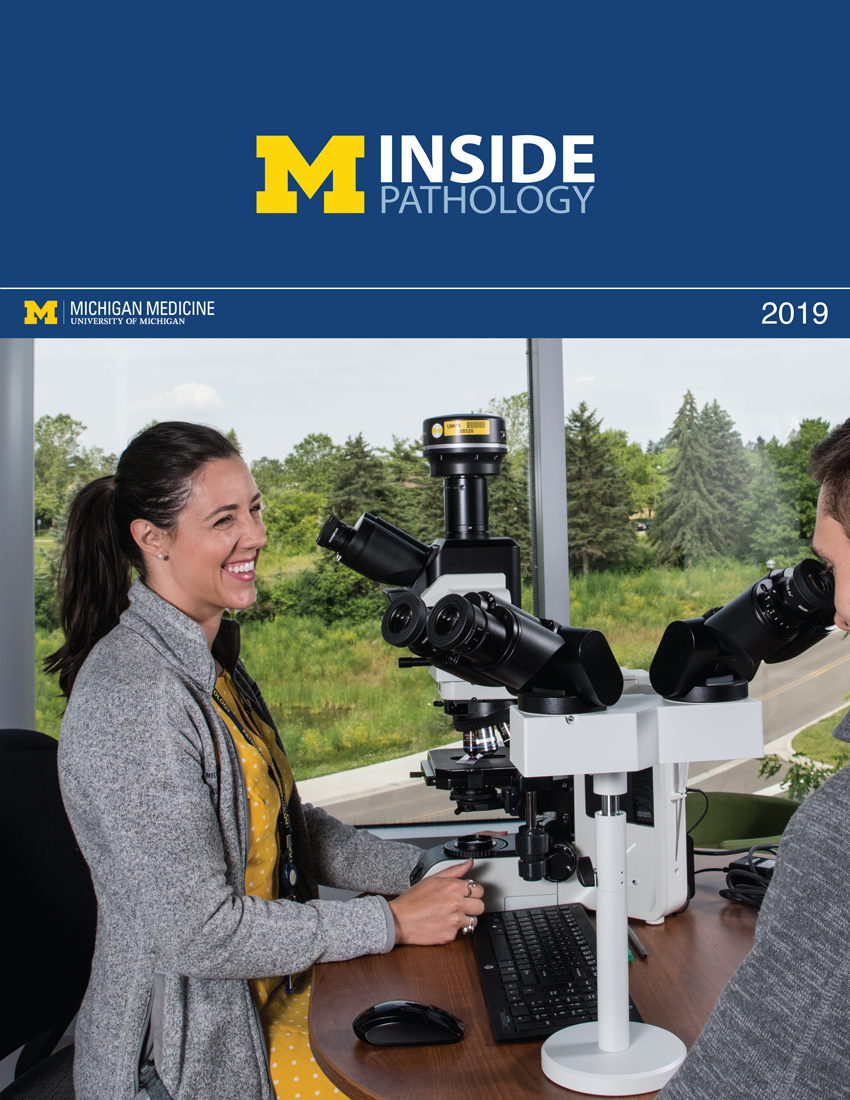 ON THE COVER
ON THE COVER
Residents Ashley Bradt (left) and William Perry work at a multi-headed scope in our new facility. 2019Department Chair |

newsletter
INSIDE PATHOLOGYAbout Our NewsletterInside Pathology is an newsletter published by the Chairman's Office to bring news and updates from inside the department's research and to become familiar with those leading it. It is our hope that those who read it will enjoy hearing about those new and familiar, and perhaps help in furthering our research. CONTENTS
|
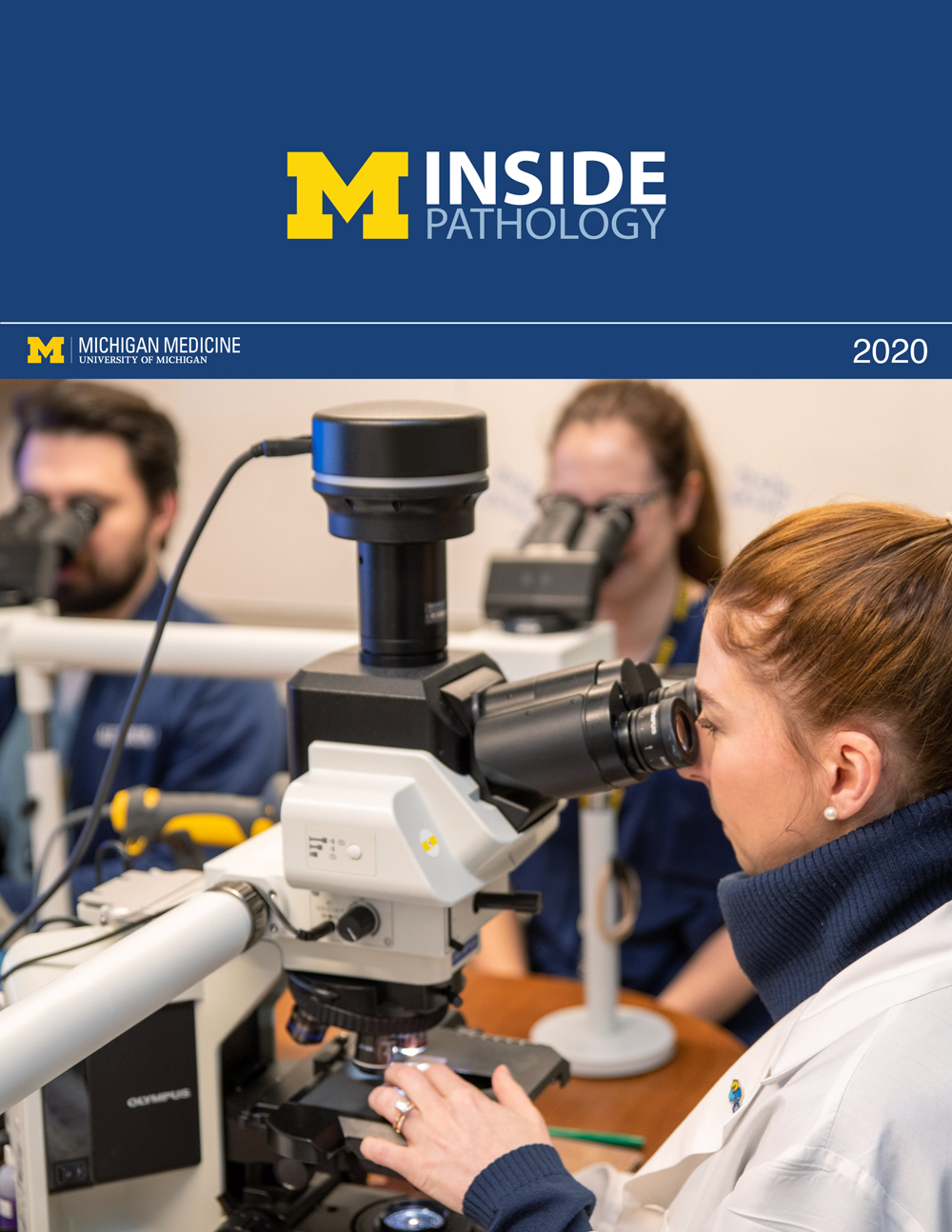 ON THE COVER
ON THE COVER
Dr. Kristine Konopka (right) instructing residents while using a multi-headed microscope. 2020Department Chair |

newsletter
INSIDE PATHOLOGYAbout Our NewsletterInside Pathology is an newsletter published by the Chairman's Office to bring news and updates from inside the department's research and to become familiar with those leading it. It is our hope that those who read it will enjoy hearing about those new and familiar, and perhaps help in furthering our research. CONTENTS
|
 ON THE COVER
ON THE COVER
Patient specimens poised for COVID-19 PCR testing. 2021Department Chair |

newsletter
INSIDE PATHOLOGYAbout Our NewsletterInside Pathology is an newsletter published by the Chairman's Office to bring news and updates from inside the department's research and to become familiar with those leading it. It is our hope that those who read it will enjoy hearing about those new and familiar, and perhaps help in furthering our research. CONTENTS
|
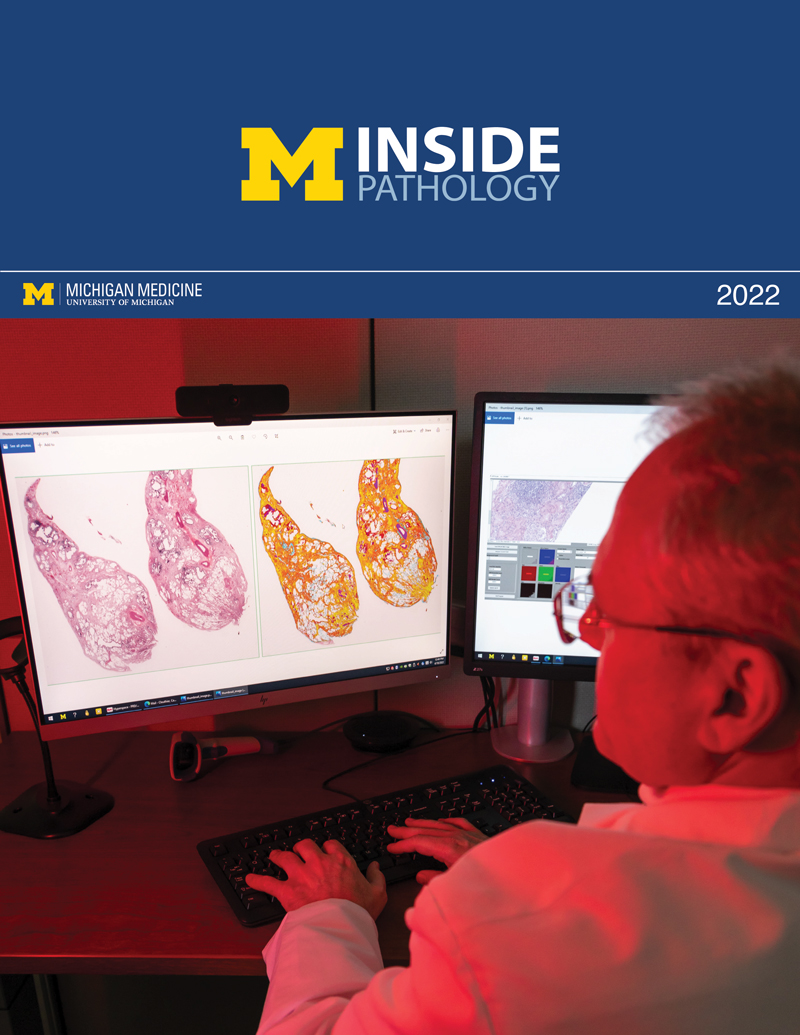 ON THE COVER
ON THE COVER
Dr. Pantanowitz demonstrates using machine learning in analyzing slides. 2022Department Chair |

newsletter
INSIDE PATHOLOGYAbout Our NewsletterInside Pathology is an newsletter published by the Chairman's Office to bring news and updates from inside the department's research and to become familiar with those leading it. It is our hope that those who read it will enjoy hearing about those new and familiar, and perhaps help in furthering our research. CONTENTS
|
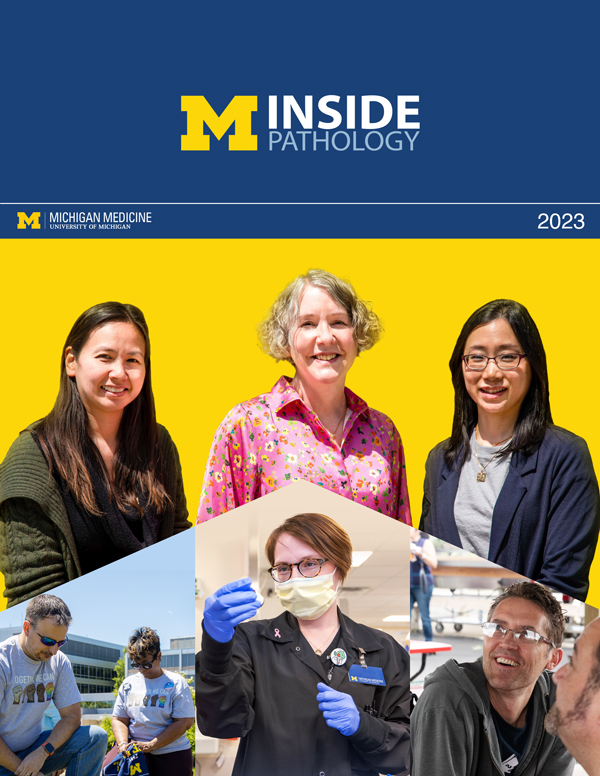 ON THE COVER
ON THE COVER
(Left to Right) Drs. Angela Wu, Laura Lamps, and Maria Westerhoff. 2023Department Chair |

newsletter
INSIDE PATHOLOGYAbout Our NewsletterInside Pathology is an newsletter published by the Chairman's Office to bring news and updates from inside the department's research and to become familiar with those leading it. It is our hope that those who read it will enjoy hearing about those new and familiar, and perhaps help in furthering our research. CONTENTS
|
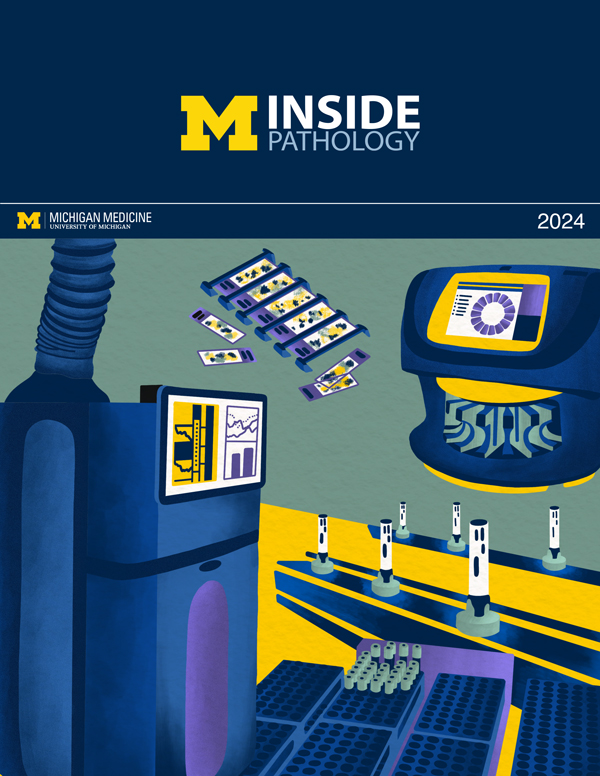 ON THE COVER
ON THE COVER
Illustration representing the various machines and processing used within our labs. 2024Department Chair |

newsletter
INSIDE PATHOLOGYAbout Our NewsletterInside Pathology is an newsletter published by the Chairman's Office to bring news and updates from inside the department's research and to become familiar with those leading it. It is our hope that those who read it will enjoy hearing about those new and familiar, and perhaps help in furthering our research. CONTENTS
|
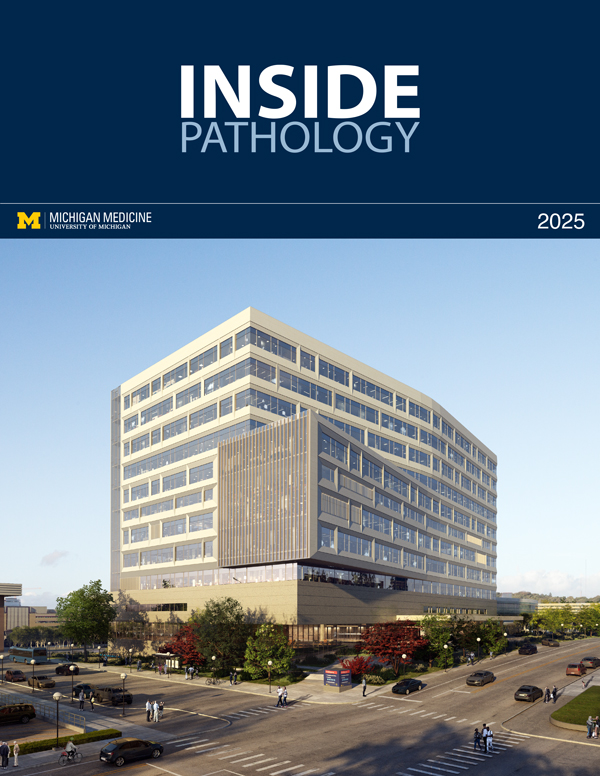 ON THE COVER
ON THE COVER
Rendering of the D. Dan and Betty Khn Health Care Pavilion. Credit: HOK 2025Department Chair |

newsletter
INSIDE PATHOLOGYAbout Our NewsletterInside Pathology is an newsletter published by the Chairman's Office to bring news and updates from inside the department's research and to become familiar with those leading it. It is our hope that those who read it will enjoy hearing about those new and familiar, and perhaps help in furthering our research. CONTENTS
|

MLabs, established in 1985, functions as a portal to provide pathologists, hospitals. and other reference laboratories access to the faculty, staff and laboratories of the University of Michigan Health System’s Department of Pathology. MLabs is a recognized leader for advanced molecular diagnostic testing, helpful consultants and exceptional customer service.